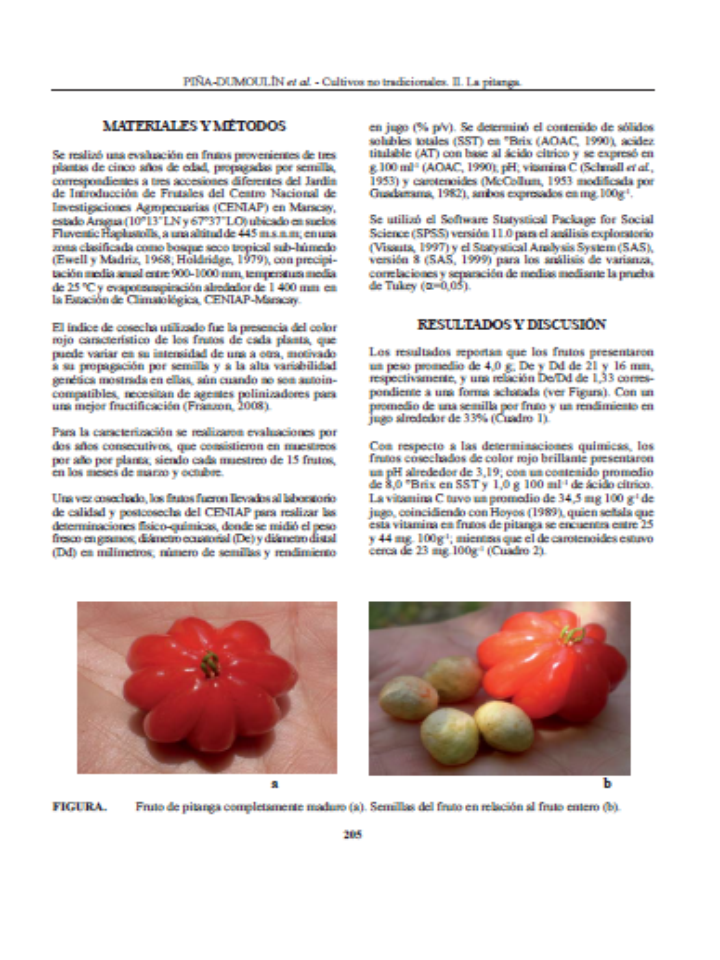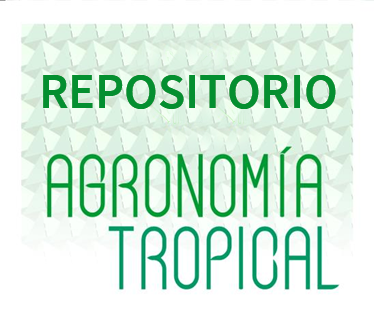Physical-chemistry characterization of fresh fruits of no traditional cultivations in Venezuela. II. The pitanga
Abstract
The pitanga, Eugenia uniflora L., is a native fruit of Brasil with important nutritious qualities and wide adaptation to different conditions of climate, soil and handle. This fruit has been introduced to Argentina, Colombia, and Venezuela, although it is little known in this last. Fruits harvested of three plants at the Fruit Repository Garden from CENIAP were evaluated by two consecutive years, with the purpose to determinate its physical-chemistry characteristics under the conditions of Aragua state. Besides assessing its production potential in small rural communities as sources of vitamins when is consumed as fresh fruit. Fresh weight, equatorial and distal diameter and its relation was measured in a total of 60 fruits for each plant. Seeds number; juice yield; total soluble solids (TSS); titratable acidity; pH; Vitamin C and carotenoids, were determined. The fruits are flat with averages values from 4,0 g, 2 seeds, 8.0 °Brix, 1.0 g.100 ml-1 for citric acid and 33% yield of juice. The results are in agreement with the reported ranges in the Amazonical native zone. Furthermore, confirming its high vitaminic content based in the carotenoids concentration.
Downloads
References
• Ewell, J. y A. Madriz. 1968. Zonas de vida de Venezuela. Dirección de Investigación. Ministerio de Agricultura y Cría (MAC). Caracas. 264 p.
• Filho, G., V. de Rosso, A. Meireles, R. Paulo, A. Oliveira, A. Mercadante y F. Cabral. 2008. Supercritical CO extraction of carotenoids from pitanga fruits (Eugenia uniflora L.). The Journal of Supercritical Fluids. 46:33-39.
• Franzon, R. 2008. Propagação vegetativa e modo de reprodução da pitangueira (Eugenia uniflora L.) Tesis de Doctorado. Universidad Federal de Pelotas. Argentina. 100 p.
• Freyre, M., C. Baigorria, V. Rozycki, C. Bernardi y M. Charpentier. 2000. Vegetales silvestres subexplotados del Chaco argentino y su potencial como recurso alimenticio. ALAN. 50(4):394-399.
• Gomes, A. and M. Bezerra. 2009. Reproductive success of four species of Eugenia L. (Myrtaceae). Acta bot. Bras. 23(2):526-534.
Griffis, J., T. G. Mcdonald, V. E. Smith and M. M. Manners. 2009. Eugenia uniflora a nutritious, easy-to-grow fruit for the tropics. In: H. Jaenicke, J. Ganry, I. Hoeschle-Zeledon, R. Kahane Disponible en: https://bit.ly/2Ut82oC
• Guadarrama, A. 1982. Cambios químicos y actividad respiratoria durante la maduración de frutos de semeruco, Maracay, Venezuela. Trabajo de Ascenso. Universidad Central de Venezuela. Facultad de Agronomía. 87 p.
• Holdridge, L. 1979. Ecología basada en zonas de vida. Editorial IICA. Serie: Libros y Materiales Educativos N° 34. San José. 9 p.
• Hoyos, J. 1989. Frutales de Venezuela. Sociedad de Ciencias Naturales La Salle. Monografia Nº 36, 174-175 pp.
• McCollum, J. P. 1953. A rapid method for determining total carotenoids and carotene in tomatoes. Pro. Amer. Hort. Sci. 61:431-433.
• Morton, J. 1987. Surinam cherry. In: Fruits of warm climates. Miami, FL, 386–388 pp.
• Porcu, O. and D. Rodríguez-Amaya. 2008. Variation in the carotenoid composition of the lycopene-lich Brazilian fruit Eugenia uniflora L. Plant food for human nutrition. 63(4):195-199.
• Ricciardi, A., J. Ruiz, G. Ricciardi y A. Agrelo. 1999. Sesquiterpeno aislado de los aceites esenciales de Eugenia uniflora L. y Eugenia uniflora var. Vermillion (Ñangapirí). Trabajo Especial. UNNE. Resúmenes ampliados en Actas Reun. Comun. Cient (ISBN 950-656-047-1). Argentina, 8: 97-99.
• Rodríguez-Amaya, D. 2005. Analysis and Composition of Brazilian Foods. In: Presentations to the consultation on the cross-cutting initiative on biodiversity for food and nutrition. Brasilia.
• Schmall, M., C. W. Pifer and E. G. Wollish. 1953. Determination of ascorbic acid by a new colorimetric reaction. An. Chem. 25(10):1 486-1 490.
• Statistical Analysis system (SAS). 1999. SAS online. Version 8.0. Cary, NC. USA.
• Villachica, H., J. E. Uran, C. Hans, C. Díaz y M. Almanza. 1996. Frutales y Hortalizas Promisorios de la Amazonia. Tratado de Cooperación Amazónica. Lima. 44:228-230.
• Visauta, B. 1997. Análisis Estadístico con SPSS para Windows. Estadística básica. Ed. McGraw Hill/ Interamericana de España, 304 p.





